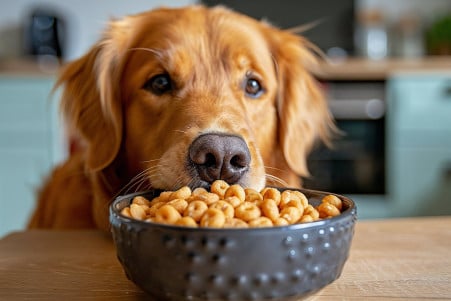Can Dogs Eat Grits? Nutritional Facts and Tips for Feeding Your Dog
10 February 2024 • Updated 10 February 2024

If you’re thinking about letting your dog join you at the breakfast table, you may wonder if grits are a good option. While grits are safe for dogs to eat as an occasional treat, there are some important caveats. Dogs with a sensitivity to corn or those who are overweight should avoid grits, and dogs should never eat grits that contain butter, salt, or other seasonings.
As always, it’s important to talk to your vet before introducing new items into your dog’s diet.
In this article, we’ll take a closer look at veterinary nutritional recommendations and research on dog nutrition to help you understand the potential impacts of feeding your dog grits. We’ll investigate the nutritional value of grits, as well as the potential benefits and drawbacks of feeding them to dogs.
We’ll conclude with information on portion sizes. This information will help you better understand your dog’s dietary needs and make the best choices for their health.
Can dogs eat grits?
Grits in a Dog’s Diet: Nutritional Breakdown and Considerations
Grits are a type of porridge made from cornmeal that is a common part of the human diet, but their place in a dog’s diet is less straightforward. According to Rover.com, grits are high in carbs and low in protein, which means they can provide energy but not the full range of nutrients a dog needs.
The ASPCA warns that treats like grits should not account for more than 10% of a dog’s daily calories, which means they should be an occasional treat rather than a regular part of a dog’s diet.
The biggest problem with feeding dogs grits is that they don’t provide a lot of nutrition. As A-Z Animals explains, while grits do contain some vitamins and minerals, including vitamin E and iron, they don’t have the essential amino acids and fatty acids that dogs need for a complete diet, according to WebMD.
As a result, if a dog’s diet is already nutritionally complete and meets the AAFCO’s (Association of American Feed Control Officials) standards for a balanced diet, dog owners can feed their pets grits without worrying about nutritional imbalances.
That said, dog owners should still be careful about feeding their pets grits and make sure they do so in moderation. It’s important to make sure that dogs don’t eat grits too often or in amounts that are too large to help maintain their overall health and nutritional balance.
Pros and Cons of Feeding Grits to Dogs
Before feeding your dog grits, it’s important to understand the potential benefits and drawbacks. According to MasterClass, plain cooked grits can be a good source of carbohydrates for dogs, which can help fuel their bodies. However, A-Z Animals pointed out that the nutritional value is limited because grits don’t contain the essential proteins and nutrients that dogs need.
One of the biggest drawbacks to feeding your dog grits is that they can contribute to weight gain because they are high in carbohydrates. According to the Association for Pet Obesity Prevention, the carbohydrates in grits can contribute to obesity in dogs, which can lead to other health problems like joint issues and diabetes.
In addition, the seasonings and other ingredients that are often added to grits when they are prepared for humans, such as salt, garlic, or onions, can be toxic to dogs, according to veterinarians from the Cummings School of Veterinary Medicine at Tufts University. These ingredients can cause pancreatitis or other toxic reactions.
In addition, dogs that are allergic to grains may be allergic to corn-based grits and experience symptoms like skin problems or digestive issues.
To avoid these issues, it’s important to feed your dog grits in moderation. Grits should be fed plain, without any other ingredients, and in amounts that are appropriate for the dog’s size and nutritional requirements. Properly preparing grits and introducing them to your dog’s diet slowly can help you watch for any signs of problems and make sure that they are safely included in your dog’s diet.
What Makes a Healthy Diet for Dogs?
A healthy diet for dogs is made up of a variety of essential nutrients. Proteins and amino acids are the building blocks of muscles and are necessary for the body to function properly; fats are a source of energy and help maintain skin and coat health; minerals help with bone growth and fluid balance; and vitamins are responsible for a range of functions, including supporting the immune system and aiding in the metabolism of food.
According to the Association of American Feed Control Officials (AAFCO), which has been verified by the Cummings School of Veterinary Medicine at Tufts University, these nutrients must work together to be in balance to meet AAFCO’s requirements for a complete and balanced diet.
In the big picture, carbohydrates like the ones found in grits can be used as an energy source.
However, grits don’t provide the other essential nutrients that are required for a balanced diet, including proteins, fatty acids, vitamins, and minerals.
If dog owners want to feed their pets grits, they should make sure that the grits are a small part of their overall diet.
As the AKC notes, a small amount of cooked corn—like the corn in grits—is easy to digest and can help meet a dog’s energy needs.
That said, to avoid nutritional imbalances, grits should be part of a diet that’s made up of plenty of animal proteins, fats, and other essential nutrients.
Dog owners should focus on feeding their pets a balanced diet that includes a variety of foods and follow the detailed advice of veterinary professionals to make sure their pets get the right mix of nutrients.
Corn Allergies in Dogs: What to Know About the Risks and Benefits of Grits
Dogs can have food allergies, especially to proteins and other complex carbohydrates, which can lead to symptoms like itchy skin and digestive problems. While proteins like beef and dairy are common allergens, corn allergies, although less frequent, are real.
According to VCA Animal Hospitals, dogs are more likely to develop food allergies after being exposed to the same diet for a long time. A dog with a sensitivity to grains can have an allergic reaction to grits because they are made from ground corn, which is a grain.
The popularity of grain-free diets has grown in part because they are often recommended for dogs with grain allergies.
However, Preventive Vet points out that dogs are much less likely to be allergic to grains than other ingredients and that grain-free diets are not necessarily healthier and may even be linked to heart disease, specifically dilated cardiomyopathy (DCM), according to the U.S. Food and Drug Administration (FDA).
In addition, the ASPCA explains that while some dogs with DCM have improved after being switched to a diet that doesn’t include grains, researchers have not yet proven a direct cause—and—effect relationship between grain-free diets and DCM.
Dog owners whose pets have been diagnosed with a grain allergy should work with their veterinarian to develop a diet that meets their pet’s needs. This means taking a more balanced approach that avoids known allergens and potentially dangerous “BEG” (boutique, exotic, grain-free) diets. This way, a dog can get the nutrition they need without experiencing an allergic reaction or other health problems, resulting in a diet that’s both safe and healthy.
How to Feed Your Dog Grits
If you want to feed your dog grits, it’s important to focus on safety and simplicity. First, make sure you buy plain corn grits and avoid instant grits, which can have additives that aren’t safe for dogs.
According to DogTime, you should also soak and cook the grits to make sure they’re fully cooked and easy for your dog to digest. Don’t add butter, salt, or any other seasonings that could be harmful to your dog.
The amount of grits you can feed your dog will vary based on their size and dietary needs. A small amount mixed in with their regular food is enough for a taste. Like any treat, grits should make up no more than 10% of your dog’s daily calories. Spoiled Hounds recommends feeding your dog grits as a treat only since they’re high in carbohydrates and low in nutrients.
You should also introduce grits slowly and watch your dog for signs of digestive issues or allergies, especially if your dog is sensitive to grains. If you’re not sure, ask your vet before you change your dog’s diet. If you follow these steps, you can safely add a small amount of grits to your dog’s diet without putting their health at risk.
Final Thoughts on Dogs and Grits
So, in short, dogs can eat grits as long as they are plain and cooked, but it is important to avoid seasonings and other additives that can be toxic to dogs.
As mentioned by Rover.com and A-Z Animals, grits should be considered a special treat and not a regular part of your dog’s diet, and they should never account for more than 10% of your dog’s daily caloric intake.
It is also important to remember that grits are low in protein and other important nutrients, so they can’t replace a complete and balanced dog food diet, which is something that the American Association of Feed Control Officials also emphasizes.
Make sure to talk to your vet before you give your dog grits or any other new food, especially because of the risk of food allergies and the potential for weight gain. Ultimately, it is up to you as a pet owner to make sure that your dog is getting all of the nutrients that they need from their diet.
So, as you put the lid back on the container of grits, remember that the best diet for your dog is one that is complete, balanced, and approved by your vet. While treats like grits can be a nice change of pace, they should never take the place of the basics of good dog nutrition.


